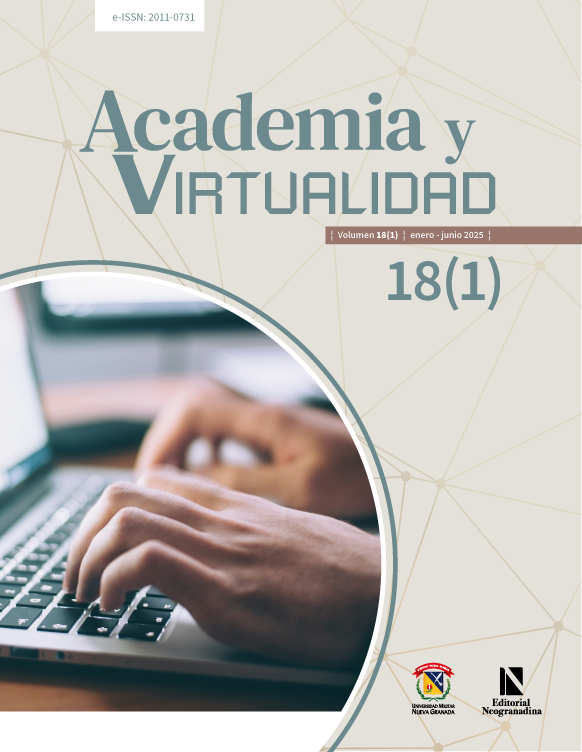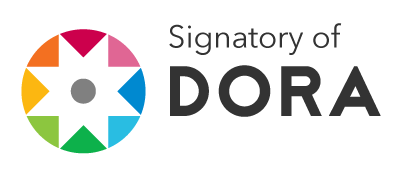The Use of the GeoGebra Digital Tool in Transforming Students' Beliefs about Probability
Abstract
This work aims to identify some initial beliefs that sixth-grade students hold regarding the concept of probability and assess the impact of using the digital tool GeoGebra on students' belief systems. The qualitative study was conducted within the design-based research paradigm, employing a teaching experiment as the methodological strategy. Participants in the study were sixth-grade students from a public educational institution in the city of Cali, Colombia. The results reveal that students hold diverse beliefs about probability, varying based on their level of reasoning. Moreover, the use of multiple representations provided by GeoGebra simulations served as the means through which students progressed from sometimes erroneous beliefs about probability to mathematical argumentation.
Downloads
References
Alsina, Á. y Salgado, M. (2019). Ampliando los conocimientos matemáticos en Educación Infantil: la incorporación de la probabilidad. Revista de Estudios y Experiencias En Educación, 18(36), 225–240. https://doi.org/10.21703/rexe.
Amir, G. S. y Williams, J. S. (1999). Cultural influences on children’s probabilistic thinking. Journal of Mathematical Behavior, 18(1), 85–107. https://doi.org/10.1016/s0732-3123(99)00018-8
Ang, L. H. y Shahrill, M. (2014). Identifying Students’ Specific Misconceptions in Learning Probability. International Journal of Probability and Statistics, 3(2), 23–29. https://doi.org/10.5923/j.ijps.20140302.01
Batanero, C., Chernoff, E. J., Engel, J., Lee, H. S. y Sánchez, E. (2016). Research on Teaching and Learning Probability. https://doi.org/10.1007/978-3-319-31625-3_1
Batanero, C., Gea, M. M. G. S. y Álvarez-Arroyo, R. (2023). La educación del razonamiento probabilístico. Educação Matemática Pesquisa Revista Do Programa de Estudos Pós-Graduados Em Educação Matemática, 25(2), 127–144. https://doi.org/10.23925/1983-3156.2023v25i2p127-144
Baumanns, L. y Rott, B. (2022). Identifying Metacognitive Behavior in Problem-Posing Processes: Development of a Framework and a Proof of Concept. International Journal of Science and Mathematics Education. https://doi.org/10.1007/s10763-022-10297-z
Bingolbali, F. y Bingolbali, E. (2019). One curriculum and two textbooks: opportunity to learn in terms of mathematical problem solving. Mathematics Education Research Journal, 31, 1–21.
Budgett, S., y Pfannkuch, M. (2019). Visualizing Chance: Tackling Conditional Probability Misconceptions (pp. 3–25). https://doi.org/10.1007/978-3-030-03472-6_1
Callejo, M. L., y Vila, A. (2003). Origen y formación de creencias sobre la resolución de problemas. Estudio de un grupo de alumnos que comienzan la educación secundaria. Boletín de La Asociación Matemática Venezolana, X (2), 173–194.
Callejo, M. L., y Vila, A. (2004). Matemáticas para aprender a pensar: el papel de las creencias en la resolución de problemas (Vol. 100) (Narcea, Ed.).
Callingham, R., Watson, J. y Oates, G. (2021). Learning progressions and the Australian curriculum mathematics: The case of statistics and probability. Australian Journal of Education, 65(3), 329–342. https://doi.org/10.1177/00049441211036521
Camargo, L. (2021). Estrategias Cualitativas de investigación en educación matemática (1st ed.). Ed. Universidad de Antioquia-Universidad Pedagógica Nacional de Colombia.
Charles, R. y Lester, F. (1982). Teaching problem solving. What, why, how.
Eisenmann, P., Novotná, J., Přibyl, J., y Břehovský, J. (2015). The development of a culture of problem solving with secondary students through heuristic strategies. Mathematics Education Research Journal, 27(4), 535–562. https://doi.org/10.1007/s13394-015-0150-2
Erazo, J. D. y Aldana, E. (2015). Sistema de creencias sobre las matemáticas en los estudiantes de educación básica. Praxis, 11(1), 163–169.
Fajardo y Benítez, D. (2020). influencia de las creencias de los estudiantes en la resolución de problemas en educación matemática. Revista de Educación Matemática, 35(3).
Fajardo-Valencia, A. (2023). Creencias iniciales de los estudiantes sobre probabilidad. Praxis, Educación y Pedagogía, 8. https://doi.org/10.25100/praxis_educacion.v0i8.12424
Fajardo-Valencia, A. (2023). Mediación de herramientas digitales en las creencias de los estudiantes sobre el concepto de probabilidad y su incidencia en la resolución de problemas.
Galende, N., Rojo, V. y Arrivillaga, A. (2019). Teaching-Learning Mathematics. 27(2), 88–110.
García-García, J. I., Arredondo, E.-H. y Torres, M. M. (2018). Desarrollo de la noción de distribución binomial en estudiantes de bachillerato con apoyo de tecnología. Revista Paradigma, 39(December 2018), 92–106.
Gómez Chacón, I. (2003). La tarea intelectual en matemáticas. Afecto, meta-afecto y los sistemas de creencias. Boletín de la Asociación Matemática Venezolana, 10(2), 225–248.
Groth, R. E., Austin, J. W., Naumann, M. y Rickards, M. (2021). Toward a theoretical structure to characterize early probabilistic thinking. Mathematics Education Research Journal, 33(2), 241–261. https://doi.org/10.1007/s13394-019-00287-w
Gürbüz, R. y Birgin, O. (2012). The effect of computer-assisted teaching on remedying misconceptions: The case of the subject “probability.” Computers and Education, 58(3), 931–941. https://doi.org/10.1016/j.compedu.2011.11.005
Halmos, P. R. (1980). The Heart of Mathematics. The American Mathematical Monthly, 87(7), 519–524. https://doi.org/10.1080/00029890.1980.11995081
Inzunza, S. (2014). Geogebra: Una herramienta cognitiva para la enseñanza de la probabilidad. Congreso Iberoamericano de Ciencia, Tecnología, Innovación y Educación, 1–11.
Jones, G. A. y Thornton, C. A. (2005). An Overview of Research into the Teaching and Learning of Probability. In Exploring Probability in School (pp. 65–92).https://doi.org/10.1007/0-387-24530-8_4
Kele, A. (2018). Factors impacting on students’ beliefs and attitudes toward learning mathematics: Some findings from the Solomon Islands. Waikato Journal of Education, 18(1), 85–92. https://doi.org/10.15663/wje.v23i1
Konold, C. (1991). Understanding Students’ Beliefs About Probability. Radical Constructivism in Mathematics Education,139–156. https://doi.org/10.1007/0-306-47201-5_7
Langrall, C. W. (2018). The Status of Probability in the Elementary and Lower Secondary School Mathematics Curriculum:The Rise and Fall of Probability in School Mathematics in the United States. In C. E. Batanero C. (Ed.), Teaching and Learning Stochastics. Monografías ICME-13 (pp. 39–50). https://doi.org/10.1007/978-3-319-72871-1_3
Lemus, M., y Ursini, S. (2016). Creencias y actitudes hacia las matemáticas. Un estudio con alumnos de Bachillerato. In .. . T. F. A J. A.
Macías, A. Jiménez, J. L. González, M. T. Sánchez, P. Hernández, C. Fernández (Ed.), Investigación en Educación Matemática XX (pp. 315–323).
Liljedahl, P. y Cai, J. (2021). Empirical research on problem solving and problem posing: a look at the state of the art. ZDM- Mathematics Education, 53(4), 723–735. https://doi.org/10.1007/s11858-021-01291-w
Markovits, Z. y Forgasz, H. (2017). “Mathematics is like a lion”: Elementary students’ beliefs about mathematics. Educational Studies in Mathematics, 96(1), 49–64. https://doi.org/10.1007/s10649-017-9759-2
Martin, V., Thibault, M. y Homier, M. (2022). Convergence and Divergence in Probability Teaching in Elementary andSecondary School in Québec: a Closer Look at Eight Teachers’ Self-Reported Practices. Canadian Journal of Science, Mathematics and Technology Education, 22(3), 659–678. https://doi.org/10.1007/s42330-022-00241-2
Martínez Padrón, O. J. (2014). Beliefs system on the mathematical 1. 14, 1–28. http://www.scielo.sa.cr/pdf/aie/v14n3/a03v14n3.pdf
Martínez-Padrón, O. (2021). El afecto en la resolución de problemas de matemática. Revista Caribeña de Investigación. Educativa, 5(1), 86–100.
Martínez-Padrón, O., Fajardo-Valencia, A. y Benítez Mojica, D. (2024). Sistemas de Creencias de los Estudiantes en la Resolución de Problemas Probabilísticos. Revista Paradigma, Vol XLV, 1-22.
McDonough, A. y Sullivan, P. (2014). Seeking insights into young children’s beliefs about mathematics and learning. Educational Studies in Mathematics, 87(3), 279–296. https://doi.org/10.1007/s10649-014-9565-z
Molina, M., Molina, J., y Castro, E. (2011). Un acercamiento a la investigación de diseño a través de los experimentos de enseñanza. Enseñanza de Las Ciencias, 29 (1) (January 2015), 75–88.
Mooney, E. S., Langrall, C. W. y Hertel, J. T. (2014). A Practitional perspective on probabilistic thinking models and rameworks. 495–507. https://doi.org/10.1007/978-94-007-7155-0_27
Moreno-Armella, L. (2017). Enfoques Emergentes en la Educación Matemática. Cuadernos de Investigación y Formación. En Educación Matemática, 0(17), 179–192.
Nicolson, C. (2005). Is chance fair? A student’s thoughts on probability. Teach Kids Math, 12(2), 83–89.
Olsson, J. (2018). The Contribution of Reasoning to the Utilization of Feedback from Software When Solving Mathematical Problems. International Journal of Science and Mathematics Education, 16(4), 715–735. https://doi.org/10.1007/s10763-016-9795-x
Olsson, J. y Granberg, C. (2019). Dynamic Software, Task Solving with or Without Guidelines, and Learning Outcomes. Technology, Knowledge and Learning, 24(3), 419–436. https://doi.org/10.1007/s10758-018-9352-5
Pajares, M. F. (1992). Teachers’ Beliefs and Educational Research: Cleaning Up a Messy Construct. Review of Educational. Research, 62(3), 307–332. https://doi.org/10.3102/00346543062003307
Parzysz, B. (2009). Simulating random experiments with computers in the classroom: indispensable but not so simple. In y A. O. C. Bardini, D. Vagost (Ed.), Proceedings of the ICTMT 9 conference. Metz: University of Metz.
Parzysz, B. (2018). Solving Probabilistic Problems with Technologies in Middle and High School: The French Case. In Broadening the scope of research on mathematical problem solving (pp. 387–397). https://doi.org/10.1007/978-3-319-99861-9
Polaki, M. V. (2002). Using instruction to identify mathematical practices associated with Basotho elementary students’growth in probabilistic thinking. Canadian Journal of Science, Mathematics and Technology Education, 2(3), 357–370. https://doi.org/10.1080/14926150209556526
Pratt, D. y Kazak, S. (2018). Research on Uncertainty. In Ben-Zvi et al. (Ed.), International Handbook of Research inStatistics Education (pp. 193–227). Springer International Handbooks of Education. https://doi.org/10.1007/978-3-319-66195-7_6
Prendergast, M., Breen, C., Bray, A., Faulkner, F., Carroll, B., Quinn, D., y Carr, M. (2018). Investigating secondary students’ beliefs about mathematical problem-solving. International Journal of Mathematical Education in Science and Technology, 49(8), 1203–1218. https://doi.org/10.1080/0020739X.2018.1440325
Polya, G. (1945). How to solve it. Princeton: Princeton University Press.
Romero López, D., y De Benito Crosetti, B. (2020). Diseño de una propuesta didáctica para el uso de simuladores virtuales en la rama sanitaria de Formación Profesional. Revista Interuniversitaria de Investigación En Tecnología Educativa,1–16. https://doi.org/10.6018/riite.383431
Sánchez, E. (2009). La probabilidad en el programa de estudio de matemáticas de la secundaria en México. Educación Matemática, 21(2), 39–77.
Sánchez, E. y Landín, P. R. (2014). Levels of Probabilistic reasoning of high school students about binomial problems. 581–597. https://doi.org/10.1007/978-94-007-7155-0_31
Sánchez y Benítez, D. (1997). Algunos acercamientos al pensamiento probabilista de los alumnos. Actas de La Undécima. Reunión de Matemática Educativa. Relme, 157–161.
Santos-Trigo, M. (2019). Problem-Solving in Mathematics Education. In S. Lerman (Ed.), Encyclopedia of Mathematics Education (Springer., pp. 129–205).
Santos-Trigo, M. y Machín, M. C. (2013). Framing the use of computational technology in problem solving approaches.Mathematics Enthusiast, 10(1–2), 279–302.
Santos-trigo, M. y Moreno-Armella, L. (2016). Posing and Solving Mathematical Problems. Posing and Solving Mathematical Problems, 189–207. https://doi.org/10.1007/978-3-319-28023-3.
Santos-Trigo, M. y Reyes-Martínez, I. (2019). High school prospective teachers’ problem-solving reasoning that involves the coordinated use of digital technologies. International Journal of Mathematical Education in Science and Technology,50(2), 182–201. https://doi.org/10.1080/0020739X.2018.1489075
Schoenfeld, A. (1985). Mathematical Problem Solving. Orlando: Academic Press Inc.
Schoenfeld, A. H. (1992). Learning to Think Mathematically: Problem Solving, Metacognition, and Sense Making in Mathematics (Reprint). Journal of Education, 196(2), 1–38. https://doi.org/10.1177/002205741619600202
Sharma, S. (2006). Personal Experiences and Beliefs in Early Probabilistic Reasoning: Implications for Research. 1(1), 177–184.
Sharma, S. (2016). Probability from a socio-cultural perspective. Statistics Education Research Journal, 15(2), 126–144. http://iase-web.org/Publications.php?p=SERJ
Son, J. W. y Lee, M. Y. (2021). Exploring the Relationship Between Preservice Teachers’ Conceptions of Problem Solving and Their Problem-Solving Performances. International Journal of Science and Mathematics Education, 19(1),129–150.https://doi.org/10.1007/s10763-019-10045-w
van Zanten, M. y van den Heuvel-Panhuizen, M. (2018). Opportunity to learn problem solving in Dutch primary school mathematics textbooks. ZDM - Mathematics Education, 50(5), 827–838. https://doi.org/10.1007/s11858-018-0973-x
Vásquez, C. y Alsina, Á. (2014). Enseñanza de la probabilidad en educación primaria. Un desafío para la formación inicial y continua del profesorado. Números. Revista de Didáctica de Las Matemáticas, 85, 5–23.
Vásquez, C. y Alsina, A. (2017). Lenguaje probabilístico: Un camino para el desarrollo de la alfabetización probabilística. Un estudio de caso en el aula de educación primaria. 454–478.
Vásquez Ortiz, C. y Alsina, A. (2019). Primary education teachers’ specialized knowledge to teach probability. Profesorado,23(1), 393–419. https://doi.org/10.30827/profesorado.v23i1.9160
Watson, J. M., Caney, A. y Kelly, B. A. (2004). Beliefs about Chance in the Middle Years: Longitudinal Change. In Mathematics Education for the Third Millennium: Towards 2010. Proceedings of the 27th Annual Conference of the Mathematics Education Research Group of Australasia, 581–588.
Yáñez, G. y Jaimes, É. (2013). Efectos de la simulación en la comprensión de la ley de los grandes números. Revista Integración,31(1), 69–86.
Zengin, Y. (2019). Development of mathematical connection skills in a dynamic learning environment. Education and Information Technologies, 24(3), 2175–2194. https://doi.org/10.1007/s10639-019-09870-x
Copyright (c) 2025 Academia y Virtualidad

This work is licensed under a Creative Commons Attribution-NonCommercial-NoDerivatives 4.0 International License.











